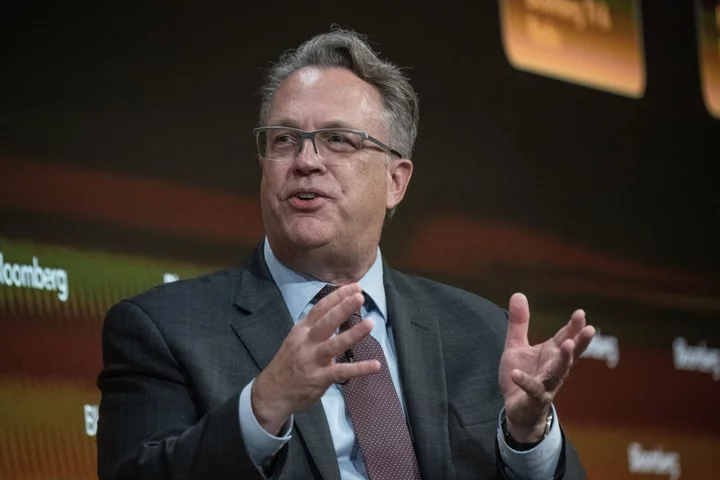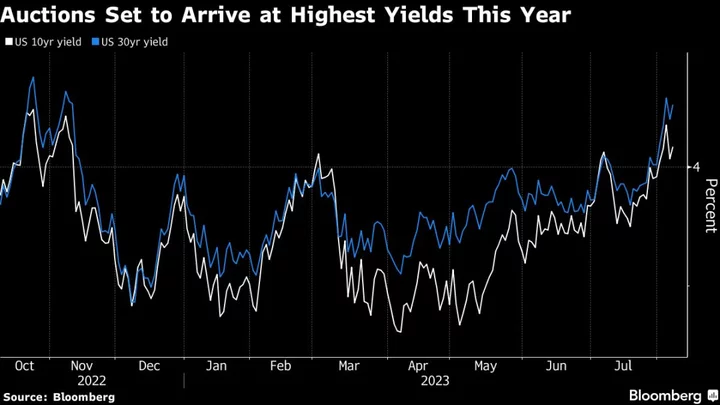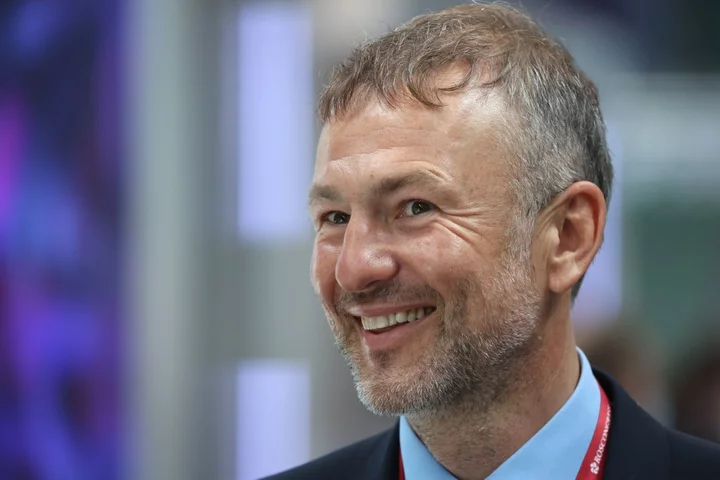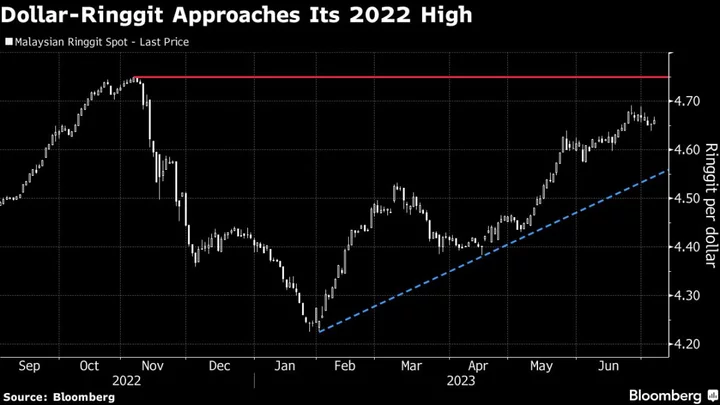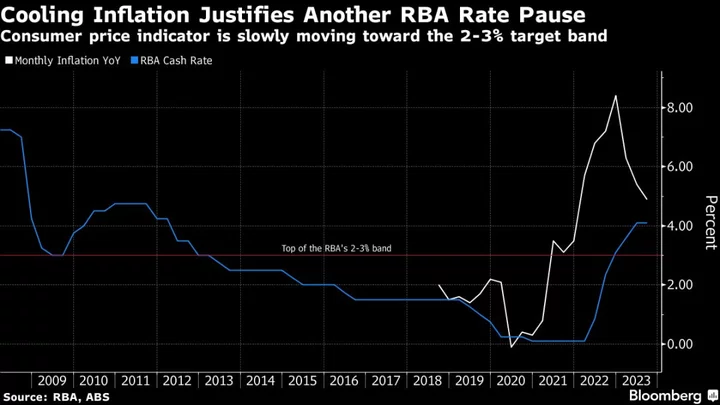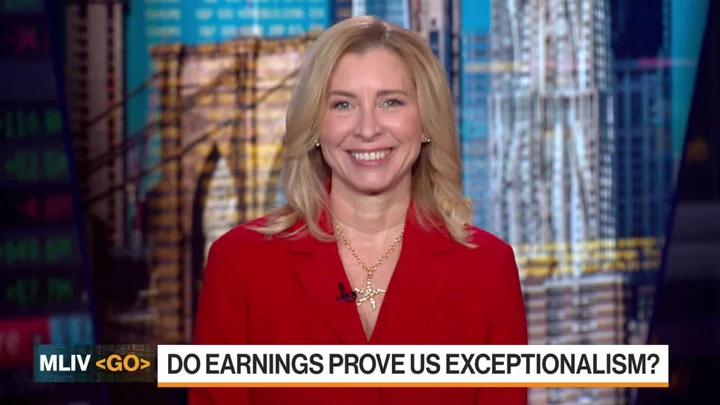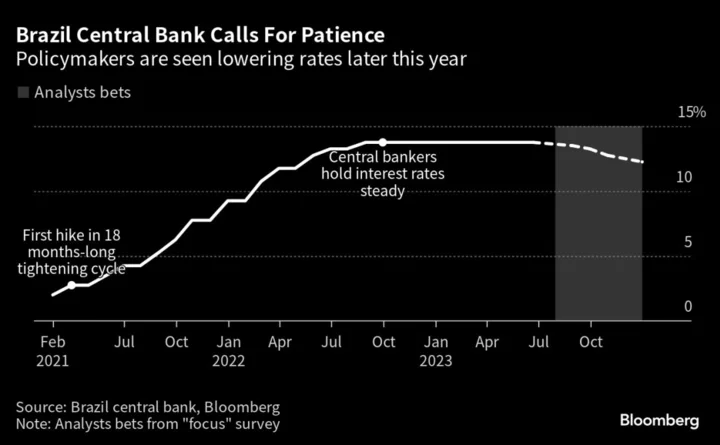Federal Reserve Bank of Cleveland President Loretta Mester says she hasn’t decided whether another interest-rate hike is still needed, adding officials have time to see how the economy is evolving.
A slew of US central bank officials and other regulators spoke across the country on Thursday, including at the New York Fed’s ninth annual Treasury Market Conference, which this year explored issues including market resilience, liquidity and the future of the Treasury cash market.
The conference, also co-hosted by the Fed, Treasury Department, Securities and Exchange Commission and Commodity Futures Trading Commission, features remarks from Fed Vice Chair Michael Barr and Liang, as well as other senior New York Fed officials and regulators.
(All times are NY)
Mester Says She Hasn’t Decided If Another Rate Hike Needed (1:52 p.m.)
Asked during a CNBC interview Thursday if she would continue to pencil in another rate increase if she had to submit projections today, Cleveland Fed President Loretta Mester said “I haven’t assessed that yet. Where I think we are right now is we’re basically in a very good spot for policy.”
“We’re at a more balanced place, but I don’t think we can say right now what necessarily the next policy meeting will be,” Mester added.
Nordstrom Says Foreign Investors Added Treasuries During Volatility (12:40 p.m.)
The New York Fed’s Anna Nordstrom said foreign investors have boosted their Treasury holdings during periods of high volatility in recent years, underscoring how safe and liquid the US government bond market is.
Foreign investors own about $8 trillion of Treasury securities, about 30% of the market, said Nordstrom, who heads domestic and international markets functions for the New York Fed’s markets group.
“We can see that the foreign private sector has increased its share of U.S. Treasury holdings for the last three years after controlling for market valuations,” she said in prepared remarks for the New York Fed conference on the Treasury market. “This high degree of interest is occurring despite FX hedging costs eroding most of the yield gain earned by buying Treasuries.”
Meanwhile, the share of Treasuries held by the foreign official sector has dropped slightly in recent years, she said. She attributed the decline largely to “idiosyncratic factors,” with some reserve managers decreasing and others lifting holdings as global FX reserve levels have plateaued.
Cook Says She’s Attuned to Risk of Sharp Slump (12:00 p.m.)
Federal Reserve Governor Lisa Cook, speaking in San Francisco on Thursday, said she is attuned to the risk of an unnecessarily sharp economic slump, pointing to strain in some sectors of the economy from tighter financial conditions that could be a harbinger of further stress.
Cook said continued momentum in economic growth and consumer spending could slow the pace of disinflation, echoing her colleagues on the Fed’s policy-setting committee. “But I am also attuned to the risk of an unnecessarily sharp decline in economic activity and employment,” Cook said at the Asia Economic Policy Conference.
Liang Says Treasury Market Resilient Amid Volatility, ICBC Hack (11:25 a.m.)
The Treasury Department’s top domestic finance official, Nellie Liang, praised smooth functioning in the US Tresaury market this year despite volatility, regional bank failures and a recent cyberhacking episode.
Read More: Liang Says Treasury Market Resilient Amid Volatility, ICBC Hack
Liang stressed that regulators’ work to bolster resiliency must continue, pointing to possible additional steps to boost transparency about trading volumes and to tamp down excess leverage, particularly in non-centrally cleared bilateral repurchase agreements.
Repo Market Functioning Becoming More Critical (11:21 p.m.)
The functioning of the repo market is becoming more critical as the supply of Treasuries is expected to grow into 2024 and buyers like the Federal Reserve continue to step away, panelists at the New York Fed’s Treasury Market Conference said Thursday.
Repo is “the heartbeat of the Treasury market,” said Richard Chambers, global head of repo trading and global co-head of the short macro trading joint venture at Goldman Sachs. Chambers, speaking on panel about bilateral repo market, added that there’s leverage in the Treasuries market and access to the repo and bilateral repo markets are an important part of markets’ functioning
“It’s important to have very robust systems because there’s going to be more dependency on the private side of the market to buy Treasuries,” Chambers said. “As more coupon supply is coming into 2024, I expect demand for leverage from the private side — hedge funds and real money accounts — to increase demand for bilateral repo to increase”
Barr Joins Chorus Warning About Hedge Funds’ Basis Trades (10:35 a.m.)
Michael Barr, the Fed’s vice chair for supervision, said the government needed more information about highly leveraged trading by hedge funds in the Treasury market. Over the past several months, regulators have been homing in on risks that could stem from one strategy known as the basis trade, which involves the use of leverage to profit from the price gap between Treasury futures and the underlying cash market.
Read More: US Weighs Leaning on Banks to Curb Hedge Fund Leveraged Trading
Leveraged trading, including in the so-called basis trade, can play an important role in capital markets and can bolster market efficiency, Barr said in remarks prepared for a New York Fed conference on the Treasury market. “But leverage can also increase risks to both market participants and to Treasury market functioning and must be managed appropriately by both investors and their counterparties, including through collecting margin to manage counterparty risk,” he said.
While flagging possible risks from a build-up this year of so-called basis trades — bets that use borrowed money to profit from tiny price discrepancies between futures and the underlying cash Treasuries — Liang also said the practice may provide some benefits. She highlighted the potential of the basis trade to improve liquidity and ultimately buoy demand for US debt.
NY Fed’s Williams, Neal Call for Greater Data Transparency (9:25 a.m.)
New York Fed officials called for greater transparency and understanding of financial-market data at the bank’s 2023 US Treasury Market Conference.
“We must continue to work together to increase data transparency and understanding, so that we can have greater market confidence and make better decisions,” President John Williams said in prepared remarks. (Williams didn’t comment on his outlook for interest rates or the economy.)
Separately, Michelle Neal, head of the New York Fed’s markets group, said greater transparency into Treasury market activity will support its many roles as a risk-free benchmark for financial instruments. Looking ahead, conference participants should consider whether to take additional steps toward increased transaction transparency across the Treasury universe, especially for less liquid segments of the market, such as off-the-runs, she said.
“The off-the-run market was the center of much of the dash-for-cash selling of Treasuries that occurred in March 2020, yet there is little data on off-the-run trading available to the public, making it challenging for academics and others to study such stress events in detail,” Neal said.
Mester Says 2% Inflation Will Take Time (9:23 a.m.)
Speaking earlier Thursday, Mester said that while inflation has cooled, it’ll take time for it to fully return to the central bank’s 2% target.
“Inflation has been running well above the Fed’s goal for more than two years and while it’s still above our 2% goal, there’s been discernible progress on inflation even while the overall economy has remained relatively strong,” Mester said Thursday in opening remarks at the bank’s Financial Stability Conference. “It’s going to take some time to get inflation back down to 2%.”
The Fed has one policy meeting left this year, in December, and officials are assessing economic conditions to see whether further interest-rate increases are needed.
If the economy evolves differently than expected “monetary policy is going to need to be nimble and respond appropriately to evolving outlook and risks to achieving both parts of our dual mandate. I believe the current level of the funds rate positions us well to do just that,” Mester said.
--With assistance from Catarina Saraiva, Alexandra Harris, Jonnelle Marte, Katanga Johnson, Liz Capo McCormick and Anya Andrianova.
(Updates with Mester remarks starting in fourth paragraph.)

